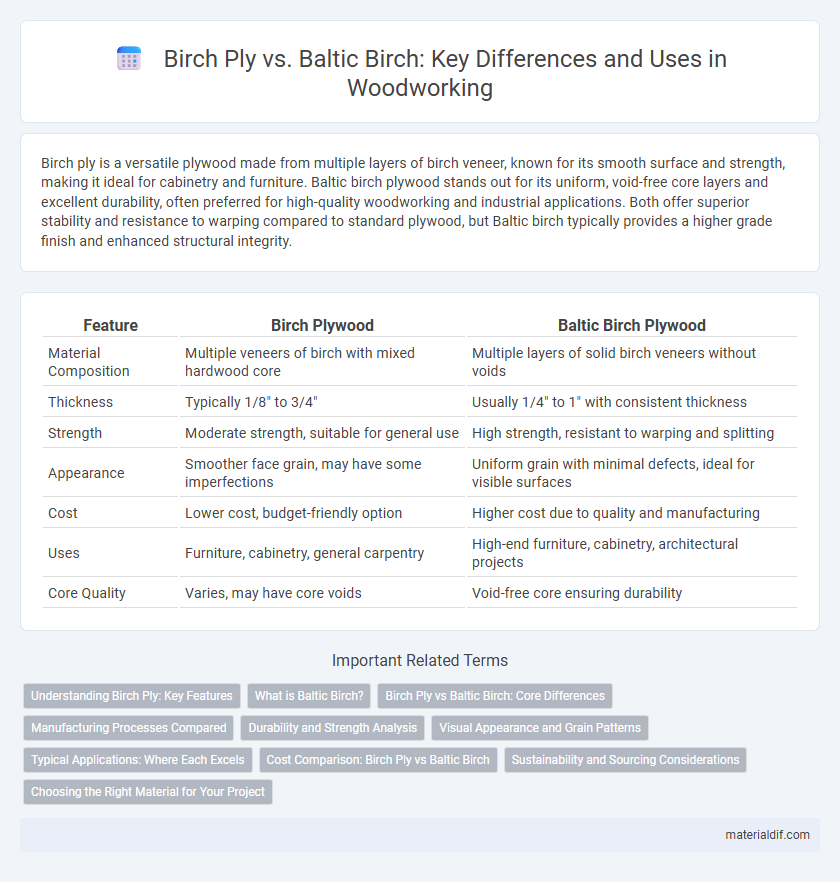Birch ply is a versatile plywood made from multiple layers of birch veneer, known for its smooth surface and strength, making it ideal for cabinetry and furniture. Baltic birch plywood stands out for its uniform, void-free core layers and excellent durability, often preferred for high-quality woodworking and industrial applications. Both offer superior stability and resistance to warping compared to standard plywood, but Baltic birch typically provides a higher grade finish and enhanced structural integrity.
Table of Comparison
| Feature | Birch Plywood | Baltic Birch Plywood |
|---|---|---|
| Material Composition | Multiple veneers of birch with mixed hardwood core | Multiple layers of solid birch veneers without voids |
| Thickness | Typically 1/8" to 3/4" | Usually 1/4" to 1" with consistent thickness |
| Strength | Moderate strength, suitable for general use | High strength, resistant to warping and splitting |
| Appearance | Smoother face grain, may have some imperfections | Uniform grain with minimal defects, ideal for visible surfaces |
| Cost | Lower cost, budget-friendly option | Higher cost due to quality and manufacturing |
| Uses | Furniture, cabinetry, general carpentry | High-end furniture, cabinetry, architectural projects |
| Core Quality | Varies, may have core voids | Void-free core ensuring durability |
Understanding Birch Ply: Key Features
Birch ply consists of multiple layers of birch veneer glued together, offering high strength and stability ideal for cabinetry and furniture making. Baltic birch, a specific type of birch plywood, features consistently thick plies with fewer voids and superior durability, making it preferred for precision woodworking projects. Understanding the difference in ply quality and layering enhances selection decisions for applications requiring smooth surfaces and structural integrity.
What is Baltic Birch?
Baltic Birch is a high-quality plywood made from multiple thin layers of birch veneer, renowned for its strength, durability, and resistance to warping compared to standard birch ply. It originates from the Baltic region and typically features a higher number of plies, often with consistent cross-grain layering that enhances stability and load-bearing capacity. This makes Baltic Birch ideal for cabinetry, furniture, and structural applications requiring superior ply performance.
Birch Ply vs Baltic Birch: Core Differences
Birch ply consists of multiple layers of birch veneer glued together, often featuring a softer core made from mixed wood species, which makes it less uniform and potentially weaker than Baltic birch. Baltic birch is distinguished by its consistent hardwood core composed entirely of birch veneers, providing enhanced strength, stability, and resistance to warping or splitting. These core differences impact the material's durability, screw-holding capacity, and suitability for high-precision woodworking projects.
Manufacturing Processes Compared
Birch ply is manufactured by layering thin sheets of birch veneer with adhesives and pressing them together, resulting in a plywood with a smooth surface primarily used in general woodworking. Baltic birch plywood consists of multiple thin, high-quality birch veneers bonded with waterproof adhesive under high pressure, producing a denser and stronger panel with minimal voids, favored for structural and precision applications. The manufacturing process of Baltic birch emphasizes uniform veneer thickness and multiple plies for enhanced durability, distinguishing it from standard birch ply which uses fewer and thicker layers.
Durability and Strength Analysis
Birch ply and Baltic birch both offer exceptional durability, but Baltic birch is renowned for its superior strength due to its multi-layered, solid core construction with minimal voids, resulting in enhanced load-bearing capacity and resistance to warping. Birch ply, made from thinner layers, tends to be lighter but less robust in comparison, making Baltic birch the preferred choice for applications requiring maximum structural integrity. The dense grain and consistent layering in Baltic birch also contribute to its greater resilience against moisture and physical impact, ensuring a longer lifespan in demanding environments.
Visual Appearance and Grain Patterns
Birch plywood features a light, creamy color with subtle, consistent grain patterns that offer a smooth and uniform visual appeal, making it ideal for contemporary designs. Baltic birch plywood showcases a more pronounced, tightly spaced grain with distinct, contrasting layers visible on the edges, providing a unique, decorative edge profile. The grain patterns in Baltic birch tend to be more intricate and textured compared to the simpler, flatter appearance of standard birch ply.
Typical Applications: Where Each Excels
Birch ply is commonly used in furniture making, cabinetry, and decorative veneers due to its smooth surface and cost-effectiveness. Baltic birch is preferred for applications requiring superior strength and durability, such as industrial shelving, toolboxes, and high-quality plywood projects. Its multi-ply construction provides enhanced resistance to warping and better load-bearing capacity in structural uses.
Cost Comparison: Birch Ply vs Baltic Birch
Birch ply generally costs less than Baltic birch due to differences in manufacturing and wood quality, making it a budget-friendly option for basic woodworking projects. Baltic birch commands a higher price because of its superior plywood layers, strength, and uniformity, which enhance durability and finish quality. For applications demanding high precision and longevity, the investment in Baltic birch often justifies the additional cost.
Sustainability and Sourcing Considerations
Birch plywood and Baltic birch differ significantly in sustainability and sourcing; Baltic birch is sourced primarily from sustainably managed forests in Northern Europe, ensuring responsible forestry practices and reduced environmental impact. Birch plywood, often sourced from various global suppliers, may have less stringent sustainability certifications, leading to variability in ecological footprint. Choosing Baltic birch supports eco-friendly manufacturing and promotes sustainable timber use due to its consistent sourcing from renewable resources.
Choosing the Right Material for Your Project
Birch ply offers a cost-effective option with a smooth surface ideal for painting and lightweight applications, while Baltic birch is favored for its durability, consistently layered construction, and excellent screw-holding ability, making it suitable for furniture and cabinetry. Selecting the right material depends on project requirements such as strength, finish, and budget. For heavy-duty or detailed woodworking projects, Baltic birch's stability and multi-ply composition provide superior performance compared to standard birch ply.
Birch ply vs Baltic birch Infographic

 materialdif.com
materialdif.com